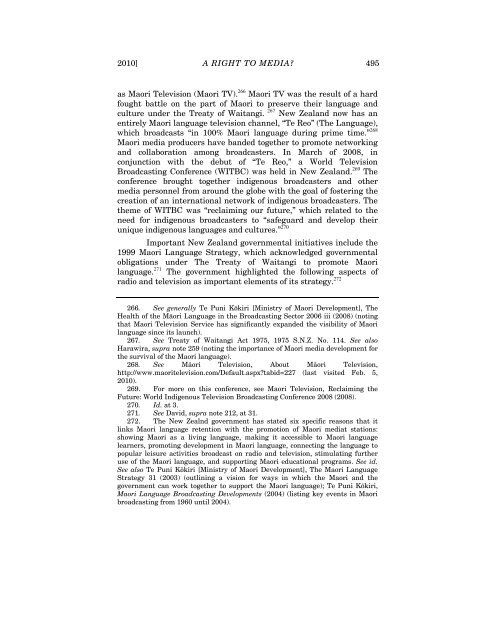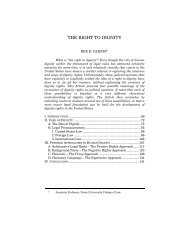A Right to Media? Lorie M. Graham - Columbia Law School
A Right to Media? Lorie M. Graham - Columbia Law School
A Right to Media? Lorie M. Graham - Columbia Law School
You also want an ePaper? Increase the reach of your titles
YUMPU automatically turns print PDFs into web optimized ePapers that Google loves.
2010] A RIGHT TO MEDIA? 495<br />
as Maori Television (Maori TV). 266 Maori TV was the result of a hard<br />
fought battle on the part of Maori <strong>to</strong> preserve their language and<br />
culture under the Treaty of Waitangi. 267 New Zealand now has an<br />
entirely Maori language television channel, “Te Reo” (The Language),<br />
which broadcasts “in 100% Maori language during prime time.” 268<br />
Maori media producers have banded <strong>to</strong>gether <strong>to</strong> promote networking<br />
and collaboration among broadcasters. In March of 2008, in<br />
conjunction with the debut of “Te Reo,” a World Television<br />
Broadcasting Conference (WITBC) was held in New Zealand. 269 The<br />
conference brought <strong>to</strong>gether indigenous broadcasters and other<br />
media personnel from around the globe with the goal of fostering the<br />
creation of an international network of indigenous broadcasters. The<br />
theme of WITBC was “reclaiming our future,” which related <strong>to</strong> the<br />
need for indigenous broadcasters <strong>to</strong> “safeguard and develop their<br />
unique indigenous languages and cultures.” 270<br />
Important New Zealand governmental initiatives include the<br />
1999 Maori Language Strategy, which acknowledged governmental<br />
obligations under The Treaty of Waitangi <strong>to</strong> promote Maori<br />
language. 271 The government highlighted the following aspects of<br />
radio and television as important elements of its strategy. 272<br />
266. See generally Te Puni Kōkiri [Ministry of Maori Development], The<br />
Health of the Māori Language in the Broadcasting Sec<strong>to</strong>r 2006 iii (2008) (noting<br />
that Maori Television Service has significantly expanded the visibility of Maori<br />
language since its launch).<br />
267. See Treaty of Waitangi Act 1975, 1975 S.N.Z. No. 114. See also<br />
Harawira, supra note 259 (noting the importance of Maori media development for<br />
the survival of the Maori language).<br />
268. See Māori Television, About Māori Television,<br />
http://www.maoritelevision.com/Default.aspx?tabid=227 (last visited Feb. 5,<br />
2010).<br />
269. For more on this conference, see Maori Television, Reclaiming the<br />
Future: World Indigenous Television Broadcasting Conference 2008 (2008).<br />
270. Id. at 3.<br />
271. See David, supra note 212, at 31.<br />
272. The New Zealnd government has stated six specific reasons that it<br />
links Maori language retention with the promotion of Maori mediat stations:<br />
showing Maori as a living language, making it accessible <strong>to</strong> Maori language<br />
learners, promoting development in Maori language, connecting the language <strong>to</strong><br />
popular leisure activities broadcast on radio and television, stimulating further<br />
use of the Maori language, and supporting Maori educational programs. See id.<br />
See also Te Puni Kōkiri [Ministry of Maori Development], The Maori Language<br />
Strategy 31 (2003) (outlining a vision for ways in which the Maori and the<br />
government can work <strong>to</strong>gether <strong>to</strong> support the Maori language); Te Puni Kōkiri,<br />
Maori Language Broadcasting Developments (2004) (listing key events in Maori<br />
broadcasting from 1960 until 2004).















